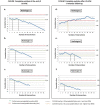Percutaneous ultrasound-guided vacuum-assisted excision of benign breast lesions: A learning curve to assess outcomes
- PMID: 30359092
- PMCID: PMC6404808
- DOI: 10.1259/bjr.20180626
Percutaneous ultrasound-guided vacuum-assisted excision of benign breast lesions: A learning curve to assess outcomes
Abstract
Objective:: To evaluate the efficacy and learning curve of ultrasoundguided vacuum-assisted excision (US-VAE) of benign breast lesions, and to assess characteristics associated with residual lesion.
Methods:: This was a retrospective study with institutional review board-approval. Sonographic and clinical follow-up were performed 6 months after intervention. Effectiveness and safety of the technique were analyzed. The cumulative summation (CUSUM) graphs were used to evaluate learning curves concerning complete excision and hematoma.
Results:: 152 ultrasound-VAEs in 143 patients were included. Initial complete resection was achieved in 90.8 % (138 of 152). 6-month follow-up was completed for 143 (94%) of cases and complete resection was observed in 72 % (100 of 143). Mean maximum size without residual tumor was 16.9 mm, while with residual lesion it was 21.9 mm (p = < 0.001), with a volume of 1.53 and 3.39 cm3, respectively (p = < 0.001). Increase in lesion size and volume was associated with less effectiveness (p = 0.05), clinical control (p = 0.05), and higher risk of clinically significant hematoma (p = 0.05). Receiver operating characteristic analysis demonstrate a volume threshold of 2.6 cm3 (r = 0.71, specificity 84.5%) for leaving no residual lesion. Cumulative summation graphs demonstrate that, on average, 11 excisions were required to acquire skills to perform complete excision in more than 80% at the end of the ultrasound-VAE and 18 excisions at 6 months.
Conclusion:: Ultrasound-VAE is an effective treatment for benign breast lesions. Breast lesion volume should be considered when assessing for percutaneous treatment.
Advances in knowledge:: A follow-up of the learning process of ultrasound-VAE will be a valuable tool to assess the efectiveness and safety of the technique i.
Conflict of interest statement
Figures


References
Publication types
MeSH terms
LinkOut - more resources
Full Text Sources
Medical

